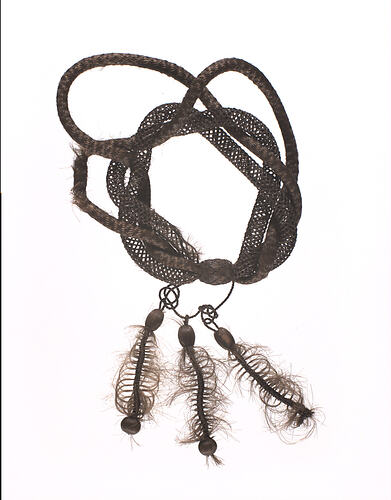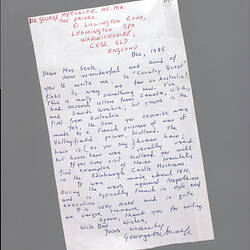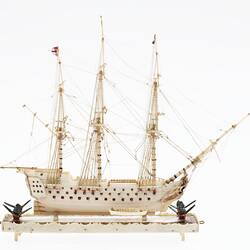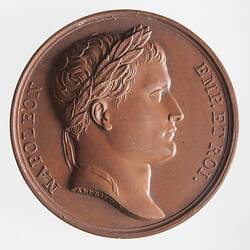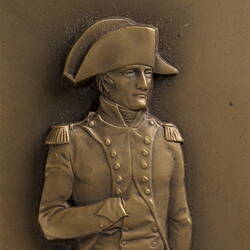Summary
Bracelet made of woven human hair, and a fragment of bracelet with woven hair inserted into clasp. Made by a French Prisoner-of-War, Valleyfield Prison, Scotland, Napoleonic Wars, circa 1810.
The items had been in the donor's family for many years. They were believed to have been made by a French prisoner-of-war at Valleyfield Prison, Scotland around the time of the Napoleonic wars. Correspondence accompanying the donation suggests the items are dated to around 1810, and are comparable to similar items in the Edinburgh Castle Museum collection.
The supplementary file contains a copy of a letter from Dr George Metcalfe, M.C., M.A, of England, dated December 1985. He was apparently the author of an article on similar work that was published in 'Country Quest' before December 1985.
He wrote to the donor: 'Yes, the item you describe was made by a French prisoner of war at Valleyfield Prison, Scotland. The hair is (as you say) human hair, but horse hair was usually used. If you ever visit Scotland, you will find examples of these bracelets in the Endinburgh Castle Museum. It was made about 1810, during the wars against Napoleon, and is typically French in style and execution. ...'
Over 1,250,000 military prisoners arrived in Britain between 1803 and 1814. Idleness and overcrowding was a problem. Gradually work was introduced to pass the time and supplement the rations. Confectionery, straw plait, model ships from beef bones, wood, hair, paper, cloth, straw and even grass were made. Many other things were made from bone, including model machines, game pieces, straw work boxes, etc. (See article in Supplementary File). The Museum holds a model ship made from beef bones by a French prisoner of war, and displayed in a framed box with a straw marquetry case.
This bracelet was presumably made for sale by a Prisoner-of-War, who used his skill to supplement his income in this way.
It, and the associated fragment, has been in the donor's family for many years.
Physical Description
Bracelet made of four strands of woven human hair. Two are tightly woven and two are loosely woven and feel springy to the touch. Strands are joined by a hair covered bead, possibly made of wood. Three tassels hang from the bracelet. These are tightly plaited but hair has been pulled out of the plait to form a feathered effect. Separate fragment of bracelet with chased effect, with woven hair inserted into clasp.
Significance
The supplementary file contains a copy of a letter from Dr George Metcalfe, M.C., M.A, of England, dated December 1985. He was apparently the author of an article on similar work that was published in 'Country Quest' before December 1985.
He wrote to the donor: 'Yes, the item you describe was made by a French prisoner of war at Valleyfield Prison, Scotland. The hair is (as you say) human hair, but horse hair was usually used. If you ever visit Scotland, you will find examples of these bracelets in the Edinburgh Castle Museum. It was made about 1810, during the wars against Napoleon, and is typically French in style and execution. ...'
Over 1,250,000 military prisoners arrived in Britain between 1803 and 1814. Idleness and overcrowding was a problem. Gradually work was introduced to pass the time and supplement the rations. Confectionery, straw plait, model ships from beef bones, wood, hair, paper, cloth, straw and even grass were made. Many other things were made from bone, including model machines, game pieces, straw work boxes, etc. (See article in Supplementary File). The Australian National Maritime Museum holds a model ship made from mutton bones by a French prisoner of war at Edinburgh Castle - registration no. 00008530.
This bracelet was presumably made for sale by a prisoner of war, who used his skill to supplement his income in this way. It, and the associated fragment, has been in the donor's family for many years.
More Information
-
Collecting Areas
Home & Community, Public Life & Institutions, Clothing & Textiles
-
Acquisition Information
Donation from Mrs P. Searle, 1989
-
Place & Date Made
Scotland, circa 1810
Circa dates based on dates of Napoleonic Wars -
Place Used
-
Classification
-
Category
-
Discipline
-
Type of item
-
Keywords
Essential Services, Handcrafts, Military History, Napoleonic Wars , 1803-1815
